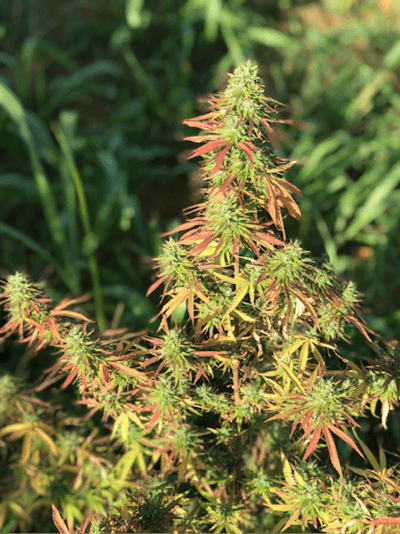

In 2020, Hawaii’s hemp farmers were struggling. Growers were in their second year operating under hemp pilot program regulations from the state’s department of agriculture, which rolled out on a tiered basis—for many, it was their first official cultivation season. The program, however, was filled with roadblocks, says Ray Maki, president of the Hawaii Hemp Farmers Association and owner of Hawaii Nexus Hemp. That included the inability to transfer hemp biomass off farms, made worse by complicated reporting and more stringent cultivation requirements than those at the federal level.
“There was just an unbelievable bureaucratic misunderstanding of the needs of the program and farmers,” Maki says.
Then, COVID-19 hit. After just two years of the state running its own pilot program, Hawaii lawmakers could not agree on a plan to fully regulate hemp, and with economic pressures from the pandemic, they decided to let the U.S. Department of Agriculture (USDA) take the reins of the state’s hemp program.
Maki says farmers were concerned over yet another change to an already challenging program. But they’ve instead experienced a pleasant surprise.
“To tell you the truth, it’s been a seamless transition to USDA,” Maki says. “It’s straightforward. We’re operating under national standards. It’s so much easier to operate under the USDA than the state program.”
To be sure, Hawaii’s program still has many challenges, Maki says. But the transition to the USDA has made those challenges fewer.
Hawaii is one of five states that has elected to hand its hemp program over to the USDA (the others are Wisconsin, North Carolina, Mississippi and New Hampshire). And as the Jan. 1 deadline rapidly approaches for states to transition out of their pilot programs, the switch could become a growing trend.
Making the Switch
States have had various reasons for electing a USDA-run hemp program, but the primary motive is budgetary.
In February 2020, New Hampshire became the first state to launch a hemp program under the USDA. The state never implemented a state-run hemp program due to the low number of farmers in the state, says New Hampshire Department of Agriculture (NHDA) Commissioner Shawn Jasper.
“When we were working with the legislature on this and looking at what it would cost for us to [create] a program, we all agreed that we would have to have a minimum number of about 100 growers to really make it economically feasible for those growers to be under a state program,” Jasper says. “Frankly, we had no one coming forward at all in New Hampshire, and so that led us to believe that the numbers were going to be extremely low in the first year.”
Mississippi followed shortly after when the state legalized hemp production that June. Despite its legalization, “the necessary funding to implement the program was not appropriated by the Mississippi Legislature,” according to the state’s website.
Hawaii made the transition in November 2020. Then, North Carolina and Wisconsin made the decision to follow suit in September 2021. Both states’ transitions will take effect Jan. 1.
In a press release, the Wisconsin Department of Agriculture, Trade and Consumer Protection (DATCP) said state Gov. Tony Evers included resources to support staffing the state’s hemp program in his budget proposal for 2021-2023, but ultimately those changes were not included in the final version of the budget.
North Carolina decided to eliminate its state-run hemp program for a few reasons—one being the end results of the USDA’s final rule, which took effect in March.
“The USDA’s rules were extremely conservative and very difficult to work with from a state perspective especially. Although they went through a revision and ultimately created what they called their ‘final rule,’ for state departments of agriculture, it remains onerous, and there are issues with trying to fund it all,” says Paul Adams, industrial hemp program manager with the North Carolina Department of Agriculture and Consumer Services. “Secondly, North Carolina is in sort of a unique position in that our general assembly hasn’t given us the authority to submit a plan to USDA. So, even if we had the desire to, we have to have the legislative authority actually to carry that out, and we don’t.”
Pros and Cons
The USDA has several roles in regulating hemp programs. In summary, it administers cultivation licenses, collects information reports and takes action in the case of negligent violations. (Read about USDA’s full role, as well as what it takes for states to run their own programs.)
The USDA does not oversee processing. It also does not send out agents to sample and test hemp, as some states do, so it is up to the grower to find sampling agents. (The USDA does, however, oversee training and certifying of hemp sampling agents. Also, in a September webinar, William Richmond, USDA Agricultural Marketing Service hemp branch chief, said hemp testing labs in states with USDA-run programs have begun to offer sampling services. )
USDA-run programs have several advantages. For one, there are no licensing fees, so farmers can grow hemp without upfront regulatory costs (aside from the cost of background checks). They also require fewer resources from state departments of agriculture. Reporting cultivation figures and other information to the USDA is simple through local Farm Service Agency (FSA) offices, which many farmers are already accustomed to working with, according to sources Hemp Grower spoke with for this story.
Adams adds that states operating under the USDA could help create uniformity across the country.
“Even states that submit their own plans must at a minimum be following the rules that are outlined by USDA. ... [This will] realign all the various benchmarks that have been set among the states with pilot programs and put them all at the same level," he says. "I think that [will] be good for interstate commerce and create some consistency that hasn’t been available up until now.”
On the other hand, Zachary Gihorski, associate director of public policy for the National Association of State Departments of Agriculture (NASDA), says one advantage of states running their own programs is having quicker and easier access to data.
“State departments of ag, in addition to being co-regulators, are also marketers for agriculture,” Gihorski says. “So, there’s a big incentive there to be connected so they can make sure the industry’s doing well as opposed to getting second-hand information from the USDA.”
In some cases, the USDA’s program (which follows the final rule on hemp) is more lax than states’ existing hemp programs. In other states, though—especially those still operating under pilot programs—the USDA regulations can be more stringent.
Such is the case in North Carolina, where, come Jan. 1, 2022, growers will have a slightly tighter window between sampling and harvest to test their crops for total THC limit than they’re used to. The USDA has also implemented a negligence threshold of 1% THC. Producers with more than three negligent violations within a five-year period will be ineligible to participate in a licensed hemp program for the next five years.
“We have had some people test above that percentage in the past, but there will be potential consequences for doing that now,” Adams says. “Whereas before, as long as you destroyed the plant or something like that, then there was no issue. So, there may be greater consequences under the USDA for doing that.”
Blake Butler, executive director of the Southeast Hemp Association, a 501(c)(6) trade association (initially formed as the North Carolina Industrial Hemp Association), says the main concerns he hears from growers as the state makes the transition to operating under USDA is finding sustainability within the industry.
“At this point, if the FDA [U.S. Food and Drug Administration] is not going to help us, we’re going to have to get Congress to push the USDA, maybe, and help nurture the supply chain with more framework and guidelines of what to do with your crop,” he added. “... Unless something dramatically changes, a lot of [farmers] are not going to plant because there’s not a buyer.”

The Decision to Transfer
Despite some states choosing to transfer authority to the USDA, it’s not a decision that will work for every state, Gihorski says.
“[The final] rule was designed to allow states to do what’s in their best interest,” Gihorski says. “It was designed to have that flexibility, and each state is going to do it for their own reasons.”
Gihorski points to Kentucky as a success story. The state has run its own hemp program since 2014, and in that time, it’s helped submit feedback to the USDA for regulations that will help work for both farmers and regulators.
Kentucky is currently operating under its pilot program. It has submitted a plan to the USDA for approval.
Sean Southard, director of communications and public affairs for the Kentucky Department of Agriculture, says the program has maintained success by remaining engaged through the USDA’s entire regulation process.
“I think one thing that made our program successful is that we were on the forefront from when this program very first got started,” Southard says. “We also worked with law enforcement to make sure the proper safeguards were in place. We kind of brought everyone in and established an industrial hemp advisory board from all sectors of the industry .... We opened the door to having a big conversation with everybody, making sure everyone had a seat [at] the table.” (Southard says it also helped that lawmakers who hail from the state, like Senate Minority Leader Mitch McConnell, were huge hemp proponents at a national level.)
For states that have switched to the USDA, the consensus among those with at least a year of operation under their belts is that the move was the right one.
“I’m giving [the USDA] kudos for being reasonable, applying a national standard to the industry and being easy to work with,” Maki says.
Jasper of New Hampshire agrees that the state’s hemp program appears to be running smoothly under the USDA (although he adds he wouldn’t be surprised if the state does not produce hemp at all next year, as only five growers received production licenses in 2020.)
Outlook
As more states decide what to do with their programs by Jan. 1, others are considering the switch to the USDA as well.
According to a recent Hemp Grower survey of state departments of agriculture, out of 11 respondents, one—New Mexico—indicated the state is considering the switch depending on input from producers in the state.
Other respondents indicated they would be submitting a state plan in the coming months or sticking to a plan they’ve already submitted.
The USDA has so far approved updated plans for 25 states, while seven states’ plans are currently under review, as of late October. If a state does not have a USDA-approved hemp plan in place by Jan. 1, 2022, growers in that state must obtain a hemp production license through the USDA, confirms a USDA spokesperson.
Whatever situation states find themselves in come the end of the year, though, they have options to continue making hemp production available.
“USDA has the resources currently to be able to support [hemp programs] ...,” Gihorski says. “I just take [this] as a healthy sign that the flexibilities we built into the program are actually providing flexibility. … Right now, I think we’re seeing we’re able to meet states where they are.”


















